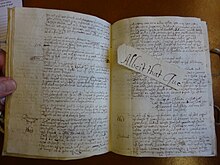Margaret Home, Countess of Moray (died 1683) was a Scottish aristocrat and compiler of recipe books.

Family background
She was the eldest daughter of Alexander Home, 1st Earl of Home (died 1619) and Mary Sutton, Countess of Home (died 1644).
Her siblings were her brother, James Home, 2nd Earl of Home (d. 1633) who married firstly, Catherine Cary (1609–1626) eldest daughter of Viscount Falkland and the playwright Elizabeth Tanfield Cary author of The Tragedy of Mariam, [1] and in 1626 married secondly Grace Fane (d. 1633) daughter of Francis Fane, 1st Earl of Westmorland and Mary Mildmay, and her younger sister, Anne Home, Countess of Lauderdale (d. 1671), who married John Maitland, 1st Duke of Lauderdale. Their daughter Mary Maitland married John Hay, 2nd Marquess of Tweeddale.
A Happy Husband
A Scottish author Patrick Hannay (fl. 1616–1630) dedicated A happy husband or, Directions for a Maide to choose her Mate, As also, a Wives behaviour towards her Husband after Marriage (Edinburgh, 1618/1619?) to Margaret Home. [2]

In October 1627 she married James Stuart, eldest son of the Earl of Moray, then known as "Lord Doune". [3] She had a nursery for her children in her mother's house in the Canongate of Edinburgh, now known as Moray House. After her brother, the Earl of Home died in 1633, she received a share of the composition of the barony of Home. She and her husband refurbished their house at Donibristle, employing English artisans including the painters, Edward Arthur [4] and George Crawford, and installed a fountain with a bronze figure of Mercury balanced on a tortoise. [5]
At Donibristle House, her cabinet included an early and luxurious telescope, bought in London in 1634 for £15 sterling. [6] Books included volumes of sermons and a work penned by Esther Inglis, [7] while Markham's Husbandry and Country Farm, a French book of plants and physic, and Parkinson's Herbal, may have been of practical use. She compiled three recipe books with the help of a clerk, including family recipes for medicines and culinary recipes supplied by a Mistress Young. A treatment diary written by her sister-in-law Grace Fane in 1628 was included, copied in Margaret Home's handwriting. [8]

In May 1650, the house in Canongate was used for the wedding party of her daughter Mary Stuart and Lord Lorne. It is said that the family and Archibald Johnston watched the captive Earl of Montrose being taken up the Royal Mile. Their encounter was depicted in 1859 by the history painter James Drummond. [9]
In 1652, Margaret Home made over lands in Moray from her dowry or terce to her husband, so that he could sell them to meet their debts. [10] He died in 1653. The Countess lived as a widow till 1683, she maintained Moray House in Edinburgh and its gardens, and planted woods at Donibristle. The writer Thomas Kirk saw the Mercury fountain in 1677. [11] After her death, her factor, the lawyer Hugh Paterson, working with one of her grandsons to make inventories, found a fortune in silver plate hidden in a cupboard at the Canongate. Hugh Paterson was the builder of Bannockburn House near Stirling. [12]
Family
Their children included: [13]
- James Stuart, Lord Doune, who married Catherine Tollemache. [14]
- Alexander Stuart, 5th Earl of Moray, who married Emilia Balfour
- Francis Stuart of Cullello
- Archibald Stuart of Dunearn, who married Anna Henderson, daughter of John Henderson of Fordell
- Margaret Stuart, who married Alexander Sutherland, 1st Lord Duffus
- Henrietta Stuart, who married Hugh Campbell of Calder
- Anne Stuart
- Anne Stuart, who married David Ross of Balnagown
- Mary Stuart, who married Archibald Campbell, 9th Earl of Argyll, at the Canongate in 1650
References
- ^ Barbara Kiefer Lewalski, Writing Women in Jacobean England (Cambridge MA, 1993), 184–5, 189: N. E. McClure, Letters of John Chamberlain, vol. 2 (Philadelphia, 1939), p. 437.
- ^ https://quod.lib.umich.edu/e/eebo/A02618.0001.001?view=toc
- ^ Scots Peerage, vol. 6, p. 321
- ^ HMC Laing Manuscripts in the University of Edinburgh, vol. 1 (London, 1914), p. 194.
- ^ P. Hume Brown, Tours in Scotland 1677 & 1681 (Edinburgh, 1892), p. 16.
- ^ Michael Pearce, 'Approaches to Inventories' in Architectural Heritage, 26 (Edinburgh, 2015)], pp. 76–77. doi: 10.3366/arch.2015.0068
- ^ Marie-Louise Coolahan & Mark Empey, 'Women's Book Ownership and the Reception of Early Modern Women's Texts', in Leah Knight, Micheline White, Elizabeth Sauer, Women’s Bookscapes in Early Modern Britain: Reading, Ownership, Circulation (Michigan, 2018), pp. 234, 238.
- ^ Marilyn M. Brown & Michael Pearce, 'The Gardens of Moray House, Edinburgh', Garden History 47:1 (2019), p. 46: NRAS 217 box 5 nos. 15, 16, 1227.
- ^ Montrose by James Drummond, NG 624
- ^ E. Dunbar Dunbar, Social Life in Former Days (Edinburgh, 1866), pp. 72–74.
- ^ P. Hume Brown, Tours in Scotland 1677 & 1681 (Edinburgh, 1892), p. 16.
- ^ Moray papers NRAS 217.
- ^ Scots Peerage, vol. 6, pp. 321–2
- ^ Charles Avery, 'Sculpture at Ham House', in Christopher Rowell, Ham House (Yale, 2013), pp. 171–2.